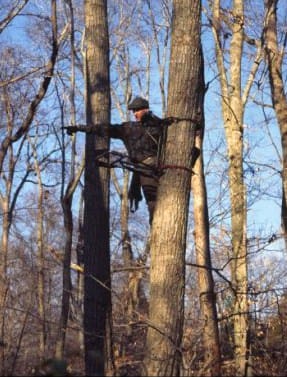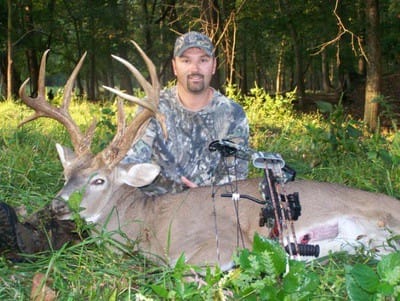
Somewhere out in the woods this deer season a hunter is perched high off the ground, his eyes sweeping the forest floor for any sign of a whitetail. He’s 30, maybe even 40 feet up, and comfortable, confident and entirely certain he’s right where he needs to be. We all know someone like that, someone who swears that climbing into the stratosphere keeps his scent up off the ground and gives him a sweeping view of the countryside and the distant horizon beyond. He kills some good bucks now and then, and he always wears a safety belt, but is it really necessary to hunt with your head in the clouds?
Absolutely not, said Luke Estel. As a whitetail fanatic with a string of giant bucks to his credit, the 34-year-old Illinois resident shifts his stand height based solely on the cover around his stand site. He rarely climbs higher than 16 feet, preferring instead to stay anywhere from 12 to 14 feet off the ground. Estel pays strict attention to wind direction, preferring to avoid areas if the wind isn’t perfect instead of relying on height to keep his scent off the ground. That often doesn’t work, he insisted.
“I go only as high as I need to in order to be out of view of passing deer,” he said. “I’m going to use low trees and brush to help conceal me, so I just want to get high enough that I’m above the shorter trees around my stand. That’s enough to keep the deer from seeing me as they walk under my stand. I might trim a few branches to give me some shooting lanes, but I don’t want to trim so many I stand out.”

So what if there is no cover? A hunter 12 feet up a tree in open oaks or along a field edge will be in plain view of any passing whitetail. The slightest movement can alert the animal to your presence. To fix that, Estel simply climbs up to no more than 18 feet and hangs his stand on the opposite side of the tree he expects to see deer. He draws his bow or raises his gun before turning around the tree to take the shot.
Why not go higher? It’s not only unnecessary, it actually decreases your shot opportunities. Estel will climb higher in hilly terrain, but only because a buck on the uphill side of his stand might be at eye level if Estel is just 12 feet off the ground. On the other hand, any deer on the downhill side will present a much more difficult shot if you climb too high.
“By going above 18 or 20 feet, you automatically put yourself at a disadvantage, especially if you are bow hunting,” he said. “The higher you go, the sharper the downward angle your shot will be. If you are 20 feet up and the deer walks right under you or just a few yards from the base of the tree, the size of the kill area decreases substantially and there is a much greater risk of missing the vitals and losing the deer.”
He noted that where you place a stand in relation to a trail or field edge will also determine the angle of the shot. If you back away a few extra yards from the area you expect to see a deer, the size of the kill zone will be larger because the angle from the stand to the deer won’t be as sharp.
Of course, safety matters, also. The higher you go, the harder you’ll hit the ground if you fall. Estel always wears a safety harness, even when he’s only 12 feet up, but many hunters still don’t wear a belt after they climb up a tree. No matter how high you go, make sure you rely on your safety device, not just when you get into your stand, but as you climb up and down, as well. Whether you climb to 25 feet or just five feet, a fall from any distance can ruin your day.



